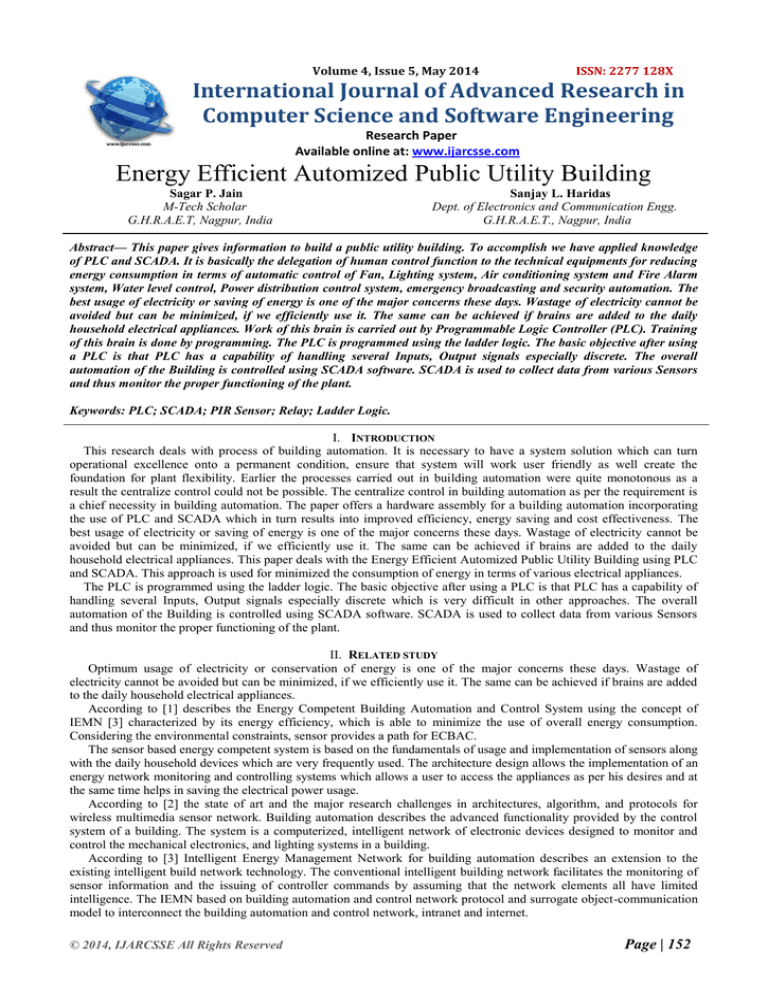
Volume 4, Issue 5, May 2014
ISSN: 2277 128X
International Journal of Advanced Research in
Computer Science and Software Engineering
Research Paper
Available online at: www.ijarcsse.com
Energy Efficient Automized Public Utility Building
Sagar P. Jain
M-Tech Scholar
G.H.R.A.E.T, Nagpur, India
Sanjay L. Haridas
Dept. of Electronics and Communication Engg.
G.H.R.A.E.T., Nagpur, India
Abstract— This paper gives information to build a public utility building. To accomplish we have applied knowledge
of PLC and SCADA. It is basically the delegation of human control function to the technical equipments for reducing
energy consumption in terms of automatic control of Fan, Lighting system, Air conditioning system and Fire Alarm
system, Water level control, Power distribution control system, emergency broadcasting and security automation. The
best usage of electricity or saving of energy is one of the major concerns these days. Wastage of electricity cannot be
avoided but can be minimized, if we efficiently use it. The same can be achieved if brains are added to the daily
household electrical appliances. Work of this brain is carried out by Programmable Logic Controller (PLC). Training
of this brain is done by programming. The PLC is programmed using the ladder logic. The basic objective after using
a PLC is that PLC has a capability of handling several Inputs, Output signals especially discrete. The overall
automation of the Building is controlled using SCADA software. SCADA is used to collect data from various Sensors
and thus monitor the proper functioning of the plant.
Keywords: PLC; SCADA; PIR Sensor; Relay; Ladder Logic.
I. INTRODUCTION
This research deals with process of building automation. It is necessary to have a system solution which can turn
operational excellence onto a permanent condition, ensure that system will work user friendly as well create the
foundation for plant flexibility. Earlier the processes carried out in building automation were quite monotonous as a
result the centralize control could not be possible. The centralize control in building automation as per the requirement is
a chief necessity in building automation. The paper offers a hardware assembly for a building automation incorporating
the use of PLC and SCADA which in turn results into improved efficiency, energy saving and cost effectiveness. The
best usage of electricity or saving of energy is one of the major concerns these days. Wastage of electricity cannot be
avoided but can be minimized, if we efficiently use it. The same can be achieved if brains are added to the daily
household electrical appliances. This paper deals with the Energy Efficient Automized Public Utility Building using PLC
and SCADA. This approach is used for minimized the consumption of energy in terms of various electrical appliances.
The PLC is programmed using the ladder logic. The basic objective after using a PLC is that PLC has a capability of
handling several Inputs, Output signals especially discrete which is very difficult in other approaches. The overall
automation of the Building is controlled using SCADA software. SCADA is used to collect data from various Sensors
and thus monitor the proper functioning of the plant.
II. RELATED STUDY
Optimum usage of electricity or conservation of energy is one of the major concerns these days. Wastage of
electricity cannot be avoided but can be minimized, if we efficiently use it. The same can be achieved if brains are added
to the daily household electrical appliances.
According to [1] describes the Energy Competent Building Automation and Control System using the concept of
IEMN [3] characterized by its energy efficiency, which is able to minimize the use of overall energy consumption.
Considering the environmental constraints, sensor provides a path for ECBAC.
The sensor based energy competent system is based on the fundamentals of usage and implementation of sensors along
with the daily household devices which are very frequently used. The architecture design allows the implementation of an
energy network monitoring and controlling systems which allows a user to access the appliances as per his desires and at
the same time helps in saving the electrical power usage.
According to [2] the state of art and the major research challenges in architectures, algorithm, and protocols for
wireless multimedia sensor network. Building automation describes the advanced functionality provided by the control
system of a building. The system is a computerized, intelligent network of electronic devices designed to monitor and
control the mechanical electronics, and lighting systems in a building.
According to [3] Intelligent Energy Management Network for building automation describes an extension to the
existing intelligent build network technology. The conventional intelligent building network facilitates the monitoring of
sensor information and the issuing of controller commands by assuming that the network elements all have limited
intelligence. The IEMN based on building automation and control network protocol and surrogate object-communication
model to interconnect the building automation and control network, intranet and internet.
© 2014, IJARCSSE All Rights Reserved
Page | 152
Jain et al., International Journal of Advanced Research in Computer Science and Software Engineering 4(5),
May - 2014, pp. 152-158
As per the [1] the architecture proposes that the usage of electricity per day consumption can be reduced that is the
wastage of energy can be reduced by adding brains to the devices. With an example of a simple room where there are
appliances such as Air Conditioner (A/C), bulbs and an automatic door. The following table shows the per hour energy
consumption by the appliance in the present scenario:
TABLE I.
Energy Consumption by Different Electronic Appliance
Component
Quantity
Per Hour Energy Consumed
Air Conditioner
1
1.335 KW
Bulb
1
0.1 KW
Automatic Door
1
0.35 KW
Component
Air Conditioner
Bulb
Automatic Door
1 Room
TABLE II.
Simulation result of [1]
Quantity
Daily Routine
1
1.335*24*1=32.04KW
4
0.1*4*24=9.6KW
1
0.35*1*10*2=7KW
48.64KW/day
Result of [1]
1.335*0.5*24=16.02KW
0.1*4.24*0.25=2.4KW
0.35*10*2*0.75=5.25KW
23.67KW/day
According to their architecture, the number of bulbs active at a time results is one fourth the number of bulbs which
are active in a single room, so when the power supply is turned on three fourth power of the total power is saved.
For the automation we are refers the various approaches, comparing the energy consumption table, the example of
one room with some features like automatic door, A/C and bulb. In table 1 the energy consumption by different
electronics appliances, the energy consumption per hour is shown. In the next table according to [1] this energy
consumption is reduce as shown in table 2. For reducing this energy consumption the Zigbee sensors approach is used.
But this approach have some problem like mainly centralize control is not possible, also by using the Zigbee
approach have low efficiency, and as use for large area like for college building it is costly because large number of
Zigbee sensors are required which is turn to more costly, also Zigbee sensors are not compatible with atmospheric
changes.
According to [2] in this approach architecture and algorithm is more complicated and controlling is not easily
possible due to uneasy to understand algorithm. In the next approach [3] the intelligent building network facilitates the
monitoring of sensor information and the issuing of controller commands by assuming that the network elements all have
limited intelligence. In the earlier approaches problems mainly centralize control is not possible which is overcome by
using the PLC and SCADA automation. So the aim of our project is to implement the knowledge of PLC and SCADA to
build the real time automation for college building and try to reduce the energy consumption.
III. RESEARCH METHODOLOGY
A. PLC
PLC is stand for Programmable Logic Controller. A PLC is control system, designed for automation processes. It uses
a programmable memory for the internal storage of user-orientated instructions for implementing specific functions such
as arithmetic, counting, logic, sequencing, and timing [5], [6]. A PLC can be programmed to sense, activate, and control
industrial equipment and, therefore, incorporates a number of I/O points, which allow electrical signals to be interfaced.
Input devices and output devices of the process are connected to the PLC and the control program is entered into the PLC
memory.
PLC is computer based solid state device that controls equipments and process. Cost effective solution due to more
number of input- output ports facility. Less labour charge as a process is automatic then there is a less requirement of
labour. Human errors reduce, once a process is automatic and programming is over then chances of errors is negligible.
Programming of PLC is based on the logic requirement of input devices and the programs implemented are
predominantly logical rather than numerical computational algorithms. Most of the programmed operations work on a
straightforward two-state “on or off” basis and these alternate possibilities correspond to “true or false” (logical form)
and “1 or 0” (binary form), respectively. The programming method used is the ladder diagram method. The PLC system
provides a design environment in the form of software tools running on a host computer terminal which allows ladder
diagrams to be developed, verified, tested, and diagnosed[5].
B. SCADA
The term SCADA stands for Supervisory Control and Data Acquisition. A SCADA system is a common process
automation system which is used to gather data from sensors and instruments located at remote sites and to transmit and
display this data at a central site for either control or monitoring purposes. The collected data is usually viewed on one or
more SCADA Host computers located at the central or master site. SCADA basically consists of data accessing feature
and controlling process remotely. SCADA refers to a system that collects data from various sensors at a building, factory,
Plant or in other remote locations and then sends this data to a central computer which then manages and controls the
data.
© 2014, IJARCSSE All Rights Reserved
Page | 153
Jain et al., International Journal of Advanced Research in Computer Science and Software Engineering 4(5),
May - 2014, pp. 152-158
SCADA is a large scale control system for automated process. SCADA is nothing but the graphical representation of
automation. SCADA systems are used to control and monitor the physical process and make online changes whenever
required[5],[7]. Previously without SCADA the process was entirely controlled by PLC, PID & micro controllers having
programmed in certain languages or codes. These codes were written in assembly language without any true animation.
So it is difficult to understand, but using SCADA we can easily understand the process if it is shown with some
animation rather than written codes.
Many industrial and infrastructure-scale enterprises depend on equipment located at multiple sites dispersed over a
large geographical area. A vast majority of large infrastructure and industrial-scale ventures use Supervisory Control and
Data Acquisition (SCADA) systems.
IV. BLOCK DIAGRAM
This block diagram gives the example of one room with basic feature like lighting control, this deals with the key
components used in the process and thus explains the use and working of each component. The block diagram of the
experimental set up is illustrated. The following configurations can be obtained.
Figure I Block Diagram
The digital computer is used as an interface between PLC and SCADA. The PLC is a micro processor based system
controller used to sense, activate and control equipments and thus incorporate a number of input output/modules which
allows electrical system to be interfaced. SCADA is a centralized system used to supervise a complete plant and basically
consists of data accessing features and controlling processes remotely. The communication protocol used is Ethernet.
The sensor is PIR Motion detector sensor use to detect the motion of live object. The room with basic feature like light
control system.
V. PLC AND RELATED SOFTWARE
The PLC is MicroLogix 1400 as it has 20 inputs and 12 outputs and has an interface for Ethernet. The MicroLogix
1400 system offers higher I/O count, faster high-speed counter, and enhanced network capabilities, the programming
software is RSLOGIX 500, Ladder logic based programming and the communication software used is RS LINX 500.
Expandable DI cards is MicroLogix 32 Point Digital Input Module, Expandable DO cards is MicroLogix 32 Point Digital
Output Module.
A. Feature of MicroLogix 1400
Ethernet port provides Web server capability, email capability and protocol support.
Built-in LCD with backlight lets you view controller and I/O status.
Built-in LCD provides simple interface for messages, bit/integer monitoring and manipulation.
Expand application capabilities through support for as many as seven 1762 MicroLogix Expansion I/O modules with
256 discrete I/O.
Two serial ports with DF1, DH-485, Modbus RTU, DNP3 and ASCII protocol support.
B. Sensors:
The sensor is PIR (Passive infrared sensor) motion detector sensor. Which is use to detect the motion of live object. A
passive infrared sensor (PIR sensor) is an electronic sensor that measures infrared (IR) light radiating from objects in its
field of view. They are most often used in PIR-based motion detectors. A PIR-based motion detector is used to sense
movement of people or animals. The Input voltage 9-16V DC, 12mA and Output voltage 12V DC.
© 2014, IJARCSSE All Rights Reserved
Page | 154
Jain et al., International Journal of Advanced Research in Computer Science and Software Engineering 4(5),
May - 2014, pp. 152-158
VI. PROCESS FLOW
Figure II. Process flow
To start the process the PIR motion detector sensor is placed in to the room. When PIR motion detector sensor sense
the motion of human body then it gives the high output. This high bit is given to the PLC. The PLC in turn gives a signal
to the inverter to start the lights. Corresponding lights is start in the region where the sensor is placed. The lights is ON
till the sensor sense the motion in the particular region, if there is no motion in to the corresponding region then the
sensor gives low output. This low bit is given to the PLC. The PLC in turn gives a signal to the inverter to OFF the lights
into the corresponding region.
The SCADA is installed in the computer and through serial port it is linked with PLC. All the field devices are
connected to PLC and they get signals from PLC. Whatever applications we want to run can be executed either through
PLC or SCADA.
VII.
SCREENSHOTS OF SCADA
Figure III. SCADA development window
Figure III shows the development window of SCADA. In this window we can developed one room with basic feature
like lightning and fan control system. In development window we are place the symbol from the wizards and write script
for that symbol. In the initial window there is a light, the condition of light is like when light is OFF it indicate with Red
colour and when the light is ON then it indicate with Green colour. For centralized control there is switch is placed in the
SCADA window. The one room is divided in to a four region that is region A, region B, region C and region D. In each
region sensor is placed.
© 2014, IJARCSSE All Rights Reserved
Page | 155
Jain et al., International Journal of Advanced Research in Computer Science and Software Engineering 4(5),
May - 2014, pp. 152-158
Figure IV. SCADA Run time window
Figure IV shows the run time window of SCADA. As we can see in figure IV the person enter in to the room at the
same time entrance light is turn ON as shown by Green colour light. This entrance light is turns ON till the other light in
to the room is not ON. When the any other light in the room is turn ON, then entrance light is automatically turn OFF.
Figure V. SCADA Run time window
Figure V shows another run time window of SCADA. As we can see in figure V the person seat into the region A, the
corresponding Lights and Fans is turns ON as light shown by green colour. And the entrance light is turned OFF. The
light in the region A is turns On till the person cover the region A, after leaving the region A the corresponding Lights
and Fans in to that region is turned OFF.
Figure VI. SCADA Run time window
© 2014, IJARCSSE All Rights Reserved
Page | 156
Jain et al., International Journal of Advanced Research in Computer Science and Software Engineering 4(5),
May - 2014, pp. 152-158
Figure VI shows another run time window of SCADA. As we can see in figure VI there is a two person seating in two
different region that is in region B and region D the corresponding lights and fans in that region is turned ON as shown
by green colour lights. And the remaining lights and fans in to the room is turn OFF. That means when person is present
in a particular region then and only then the corresponding lights and fans in that region is turn ON otherwise it is OFF.
In this way the energy consumption is reduced.
VIII.
BENEFITS OF THE PLC AND SCADA
Thousands of sensors over a wide area can be connected to the system.
Large numbers of input and output ports facility.
The computer can record and store a very large amount of data.
The data can be viewed from anywhere, not just on site.
The operator can incorporate real data simulations into the system.
The data can be displayed in any way the user requires.
Many types of data can be collected from the RTUs.
IX. CONCLUSION
In this paper conclude the overall process offers a hardware assembly for a building automation incorporates the use
of PLC and SCADA which in turn result into improved efficiency, cost effectiveness and energy saving. On the problem
of energy consumption we have a system solution which is turn operational excellence onto the permanent condition,
ensured that the system is work user friendly as well created the foundation for plant flexibility. The chief necessity of
centralize control is achieved by SCADA and PLC approach. Reducing the energy consumption in terms of lightning
control system and Fan Control system is achieved.
ACKNOWLEDGMENT
We are filled with great sense of gratitude towards teachers and who were always present when needed their help
without whom, endeavour would have been a dream. I extend my sincere thanks to Dr. Sanjay L. Haridas, Department of
Electronic and Communication, who in spite of being busy round the clock inspiration, motivation and guidance. His
own dedication in research was highly inspiring for me. I indebted to him for all the priceless help and knowledge he
imparted to me. We extend our special thanks to our principal Dr. Satish Vaishnav for giving us encouragement and
motivation to us for completing this research.
We are also grateful to all the staff members of Electronics and Communication who definitely have contributed in
their own way in out venture. We thank all the esteemed teachers for their able and timely guidance and technical advice.
The laboratory and non-teaching staff deserves a special appreciation for their excellent rapport and co-operation in the
research.
REFERENCES
[1] Shipra Kapoor, Darshan Taneja, Vaibhav Malhotra “Energy Competent Building Automation And Control System”
UACEE International jouranal of Advance Electronics Engineering Vol.2:Issue 3 ISSN 2278-215X.
[2] I.F. Akyildiz, T. Melodia, K.R. Chowdhury “Wireless Multimedia Sensor Networks: A Survey” IEEE wireless
communication 51 (4) 1536-1284, Dec. 2007.
[3] Hsiao-Yi Huang, Jia-Yush Yen, Member, IEEE, sih-Li chen, and Feng-Chu Ou, “Development of an Intelligent
Energy Management Network for Building Automation” IEEE Transactions on Automation Science and
Engineering, vol. 1, no. 1, July 2004.
[4] K.F. Tsang, Member, IEEE, KL Lam and HY Tung “Energy Management Using Zigbee” IEEE Third International
Conference on Next Generation Mobile Applications, Services and Technologies 978-0-7695-3786-3/09, 2009.
[5] Sagar P. Jain, Dr. Sanjay L. Haridas “Energy Efficient Automized Botteling Plant Using Plc And Scada With Speed
Variable Conveyor Assembly” IOSR Journal of Electronics and Communication Engineering (IOSR-JECE) e-ISSN:
2278-2834,p- ISSN: 2278-8735.Volume 9, Issue 1, Ver. II (Jan. 2014), PP 09-14.
[6] Ioan Valentin Sita “Building Control, Monitoring, Safety and Security using Collaborative Systems” IEEE Fourth
International Conference on Intelligent Networking and Collaborative Systems 978-0-7695-4808-1/12, 2012.
[7] Ji Li , Yue Zhang* “Intelligent Building Automation and Control Based on IndasIBMSTitle” 2013 International
Conference on Service Science, Apr-2013.
[8] K. Akkaya, M. Younis, “Energy-aware to mobile gateway in wireless sensor networks”, in: Proc. IEEE Globecom
2004 Workshops, November 29–December 3, Dallas, United States, 2004, pp. 16–21.
Author Profile
Sagar P. Jain
M-tech scholar in V.L.S.I. from G. H. Raisoni Academy of Engineering and
Technology, Nagpur (Maharashtra) India, received the Bachelor of Engineering degree in
Electronics and Communication Engineering from D.B.A.C.E.R., Wanadongri, Nagpur
(Maharashtra) India and completed diploma engineering in Electronics and Communication
Engineering from Dr. N. P. Hirani institute of polytechnic, Pusad (Maharashtra) India. He
published 2 research papers in reputed journals.
© 2014, IJARCSSE All Rights Reserved
Page | 157
Jain et al., International Journal of Advanced Research in Computer Science and Software Engineering 4(5),
May - 2014, pp. 152-158
Dr. Sanajy L. Haridas received Bachelor of Engineering and Master of Engineering degrees
from Nagpur University, M.S., India in 1988 and 1995 respectively. He received Ph. D. degree from
R. T. M. Nagpur University, Nagpur in 2012. Presently he is working as a Professor and Head of
Electronics and Communication Engineering department at G. H. Raisoni Academy of Engg. &
Technology, Nagpur, M. S., India. He published almost 20 research papers in various conferences
and reputed journals.
© 2014, IJARCSSE All Rights Reserved
Page | 158




